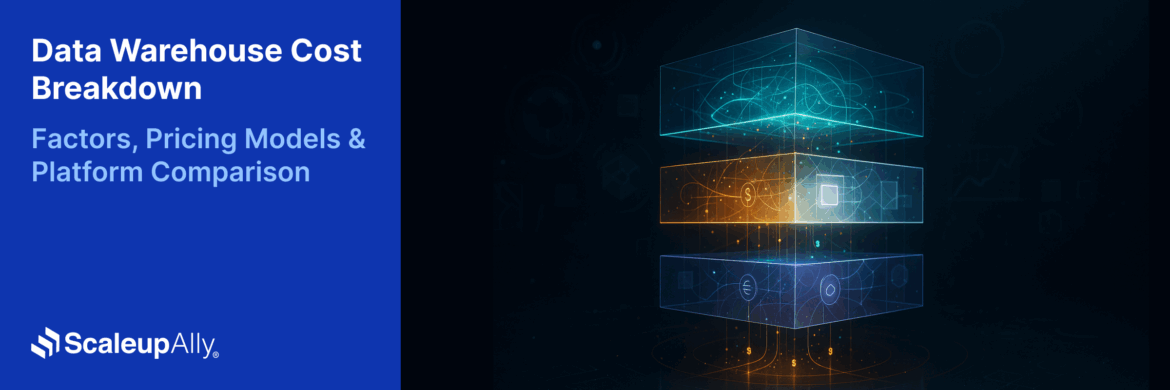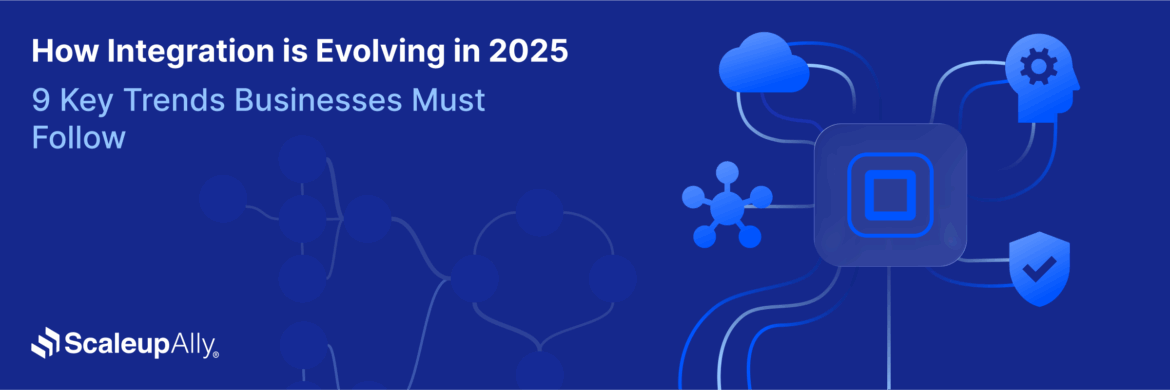![How Much Do Integrations Cost? [Pricing Breakdown & Key Insights]](https://scaleupally.io/wp-content/uploads/2025/11/How-Much-Do-Integrations-Cost_.png)
How Much Do Integrations Cost? [Pricing Breakdown & Key Insights]
Tarsem Singh | November 6, 2025 , 9 min read
Table Of Content
Software integrations connect different software tools and systems to enable data sharing. However, integrations aren’t cheap. They often come with a price tag that businesses underestimate.
The cost of integration varies. System integration costs depend on the complexity and scale of the systems involved. Data integration costs are often based on volume and frequency of data.
Understanding these factors helps you budget smartly. This guide breaks down what you’ll pay for software integrations and why those numbers matter for your business.
Key Takeaways
- Integration costs go from free built-in options to $50,000+ for custom solutions depending on what you need.
- Maintenance, training, downtime, and support can often double your initial investment.
- Smart strategies can reduce costs significantly, including using native integrations, choosing integration platforms, and prioritizing essential connections first
- The cost of integration depends on multiple factors like data volume, number of connection points, and customization needs
- Planning for scalability and regular monitoring helps keep long-term integration expenses manageable and predictable
Why Do Integration Costs Matter for Businesses?
The cost of integration isn’t always obvious upfront. Many businesses focus only on subscription fees for their software. They forget about the expenses that come with connecting everything together. This oversight can overrun your budget.
You need to consider developer time, maintenance, and potential downtime during setup. Some integrations require frequent updates, while others demand specialized expertise that comes at a cost. Understanding these costs early helps you make better decisions.
Compare different integration types and select one that fits your budget (more on that next). Factor in both immediate costs and long-term maintenance. This prevents rushed decisions and ensures your tech stack saves time instead of creating new headaches.
How Much Do Integrations Cost?
The cost of integration depends on what you want integrated and how complex the integration is. Simple integrations between popular tools might cost you nothing. Many platforms offer built-in connections that work right out of the box. But as your needs grow more specific, it becomes expensive.
The cost of system integration varies based on customization levels. Pre-built solutions do not cost much, but are less flexible. Custom builds give you exactly what you need, though the costs are not cheap.
Data integration costs are dependent on volume and complexity. Moving small amounts of basic information costs less than syncing massive databases with complex transformations. Security requirements and compliance standards also push prices higher.
Here’s a breakdown of typical integration costs:
| Type of Integration | Cost Range |
|---|---|
| In-app Integrations | Free to $50/month |
| Standard Integrations | $100 to $500/month |
| Standard Workflows | $500 to $2,000/month |
| Custom Integrations | $5,000 to $50,000+ (one-time or project-based) |
The above numbers aren’t set in stone. Your costs depend on several factors, which I will explore next.
Factors Influencing the Cost of Integration
Several elements determine how much you’ll pay for integrations. Here are some factors to consider:
1. Complexity of Systems
When you’re connecting tools with similar data structures, the process moves quickly. But legacy systems or custom-built platforms require more work. They often need special adapters or middleware to communicate properly. This complexity drives up the cost of integration significantly.
2. Volume of Data
Small data transfers happen easily and cheaply. But large-scale migrations or constant syncing of massive databases need more resources. The cost of data integration rises with volume because you need robust infrastructure to handle the load without errors or delays.
3. Number of Integration Points
Linking two systems costs less than connecting ten. Every additional integration point requires setup, testing, and maintenance. The cost of system integration multiplies as your tech stack grows. More connections also mean more potential failure points to monitor.
4. Customization Requirements
Off-the-shelf solutions work fine for standard use cases. But unique business needs require custom development. Building specialized workflows or creating proprietary connections takes time. Custom integrations deliver exactly what you want, though they push your budget higher than pre-built alternatives.
Hidden Integration Costs to Watch Out For
Sometimes, you may run into costs you never anticipated. These costs can double or triple what you expected to spend. They are “normal” to come across. Here are a few examples of such:
1. Maintenance and Updates
Software updates break connections regularly. Your integrations need constant attention to keep working smoothly. Maintenance fees add up over months and years, increasing the true cost of integration far beyond what you paid upfront.
2. Training and Onboarding
Training takes time away from regular duties. Some employees learn quickly while others struggle with new systems. You might need external trainers or dedicated internal resources. These human costs often exceed the technology expenses themselves.
3. Downtime During Implementation
Installing integrations disrupts normal operations. Systems go offline for testing and deployment. Your team can’t access critical data during transitions. Lost productivity during downtime hits your bottom line hard. The cost of system integration includes these invisible productivity losses that don’t appear on invoices.
4. Troubleshooting and Support
Problems happen even with perfect planning. Fixing these issues requires technical support. Premium support packages cost extra. Without them, you’re stuck waiting for help while your business suffers. The cost of data integration keeps climbing with each support ticket and emergency fix you need.
How to Reduce Integration Costs?
While integration costs are inevitable, there are ways to reduce them without sacrificing quality. Here’s how:
1. Start with Native Integrations
Many platforms include built-in connections to popular tools. These integrations work reliably and cost nothing extra. They reduce the cost of integration compared to custom solutions. Use them whenever possible before exploring other options.
2. Use Integration Platforms
Specialized platforms like Zapier or Make connect hundreds of apps without coding. They offer pre-built templates for common workflows. These services charge monthly fees but save thousands on development. The cost of system integration drops when you leverage existing infrastructure instead of building from scratch.
3. Prioritize Essential Integrations
You don’t need to connect everything at once. Identify which integrations deliver the most value. Focus your budget on connections that save significant time or generate revenue. Less critical integrations can wait. This phased approach spreads costs over time and prevents budget shock.
4. Plan for Scalability
Cheap solutions often fail when your needs expand. You’ll pay twice to rebuild later. Investing in scalable architecture upfront reduces long-term expenses. The cost of data integration stays manageable when your systems handle growth without major overhauls.
5. Monitor and Optimize Regularly
Review your integrations quarterly. Remove connections you’re not using. Identify bottlenecks that waste resources. Regular maintenance prevents small issues from becoming expensive emergencies. This ongoing attention keeps costs predictable and systems running efficiently.
How Can ScaleupAlly Help?
We understand that the cost of integration can strain budgets, especially for growing businesses. This is why we focus on delivering value without unnecessary expenses. Here’s how we achieve that:
1. Transparent Pricing
Right from the start, you’ll know exactly what you’re paying and why. You won’t encounter hidden fees or surprise charges later with us. Our pricing models account for the true cost of system integration, including maintenance and support. This transparency helps you plan budgets accurately.
2. Custom Solutions That Fit Your Budget
Every business has different needs and resources. So we design integration strategies that match your financial reality by finding solutions within your price range. Our team minimizes integration costs by selecting the right tools and methods for your specific needs.
3. Expert Guidance
Our experienced developers have handled hundreds of integration projects. They know where costs hide and how to avoid them. We assess your systems upfront and recommend the most efficient paths forward. This expertise prevents costly mistakes that inexperienced teams often make.
Ready to connect your systems without overspending? Contact ScaleupAlly today for a free consultation and cost estimate.
Conclusion
Understanding the cost of integration helps you budget wisely and avoid surprises because smart planning keeps expenses manageable.
Ready to connect your systems affordably? Contact ScaleupAlly today for expert guidance and transparent pricing tailored to your needs.
Frequently Asked Questions
Q: How long does it take to complete an integration project?
Simple integrations take a few days to complete. Standard workflows need two to four weeks. Custom integrations often require several months of development and testing. Your timeline also depends on how many systems you’re connecting and whether APIs are readily available.
Q: What factors affect integration pricing the most?
The number of systems you’re connecting matters. Data volume and transformation requirements also impact pricing. Customization needs push expenses up quickly. Ongoing maintenance and support add to long-term costs. Legacy systems typically cost more to integrate than modern platforms.
Q: Can low-cost integrations compromise performance?
Not necessarily. Many affordable solutions work perfectly for straightforward needs. Problems arise when cheap options can’t handle your data volume or complexity. Free tools might lack support when issues occur. Balance cost with reliability. Invest more in critical integrations that impact revenue or customer experience directly.
Q: How do I get an accurate integration cost estimate?
Start by documenting your systems and requirements clearly. List all tools you need to connect. Specify data volumes and sync frequency. Identify customization needs upfront. Consult with integration experts who can assess complexity. Request detailed quotes that include maintenance and support. Compare multiple proposals before deciding.
Related Blogs

Data Warehouse Cost Breakdown: Factors, Pricing Models & Platform Comparison
Discover how much a data warehouse costs in 2025. Explore pricing models, key factors, and platform comparisons to plan your data budget effectively.
Tarsem Singh
Nov 6 ,
14 min read

Power BI for Inventory Management: A Comprehensive Guide
Explore the hidden power of Power BI for inventory management and how it provides businesses with powerful analytics and visualization capabilities.
Tarsem Singh
Oct 8 ,
19 min read

How Integration is Evolving in 2025: 9 Key Trends Businesses Must Follow
Discover key integration trends in 2025 that will shape the future of connected systems, improve workflows, and drive business growth.
Tarsem Singh
Aug 29 ,
7 min read


